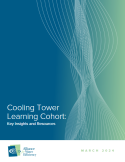Cooling Tower Learning Cohort: Key Insights and Resources

AWE recently wrapped up a learning cohort focused on Cooling Tower Efficiency alongside 15 of our members. The learning cohort consisted of utilities that met seven times from January 2023 through January 2024 to work through the cooling technology research and resources, share experiences and information, and learn from each other and from invited guests with relevant subject matter expertise. Based on this work, the cohort prepared this capstone report to highlight the resources, key insights, and some utility examples of their programs and changes that resulted from participation in the learning cohort.
The cooling tower learning cohort proved to be a valuable forum for utilities to regularly share and learn with their peers, and it allowed AWE members to gather together based on their interests and priorities. By capturing the cohort’s key insights in this short capstone report, other members can also benefit from these key insights.
This capstone report can be used as a starting point for utilities considering cooling tower water efficiency and navigating existing resources. AWE, along with its members and partners, has developed a range of cooling technology research and resources:
- The Cooling Tower Estimating Model
- How-To Guide, Creating a Cooling Tower Water Efficiency Program
- The Cooling Tower Audit Tool and Simple Return on Investment Calculator
- Comparing Alternatives Tool
- Alternative Technologies Report
- Cooling Technologies Study Project Summary
The learning cohort included staff from the following utilities:
Austin Water, Colorado Springs Utilities, East Bay Municipal Utility District, City of Goodyear Water, JEA, Los Angeles Department of Water and Power, Municipal Water District of Orange County, Orlando Utilities Commission, City of Phoenix, City of San Luis Obispo, City of Scottsdale, South Florida Water Management District, Southern Nevada Water Authority, Tampa Bay Water, and Santa Clara Valley Water District (Valley Water)





